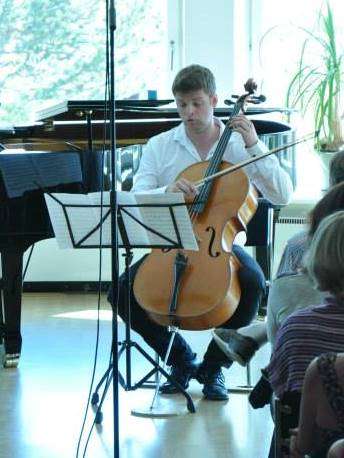|
Back
Chamber music by Sibelius gets a hearing Estonia
Pärnu Beach Hotel
07/17/2013 -
Jean Sibelius: Mazurka for Violin and Piano – Impromptu No. 5 in B Minor for Piano, Op. 5 – Allegro in D Major for Violin, Cello and Piano – Quartet "Ljunga Wirginia" for Violin, Cello and Piano Four-hands – Piano Trio "Korpo" in D Major – Valse triste (arr. Peter Lönnqvist)
Edvard Grieg: Cello Sonata in A Minor, Op. 36
Miina Järvi (violin), Marius Järvi (cello), Folke Gräsbeck, Mihkel Järvi (piano) 
Marius Järvi (Courtesy of the Pärnu Festival)
Chamber music is a vital element of the Pärnu Music Festival. The quantity and quality of talent, from guest artists to members of the top-flight Pärnu Festival Orchestra, is quite high, making smaller ensembles some of the choice offerings of the eight-day festival (July 16-23).
Worthy of special note this year was a concert featuring chamber music by Sibelius July 17 at the Pärnu Beach Hotel. Performing were members of Estonia’s very musical Järvi family, violinist Miina, cellist Marius and pianist Mihkel, joined by Finnish pianist Folke Gräsbeck. (Miina, Marius and Mihkel are children of cellist Teet Järvi, nephew of conductor Neeme Järvi and Teet’s wife, pianist Mari Järvi.)
Sibelius is best known for his symphonic works, but he left a considerable body of chamber music as well. His output includes four string quartets, the best known being Voces Intimae, Op. 56, five piano trios, a piano quartet and a piano quintet. Heard on this early evening concert at the Beach Hotel, with the Baltic Sea as a backdrop, were his Quartet “Ljunga Wirginia” for violin, cello and piano four-hands, three incidental works (Mazurka for violin and piano, Impromptu for piano and Allegro in D Major for violin, cello and piano), the Piano Trio “Korpo” in D Major and Valse triste, transcribed for violin, cello and piano four-hands by Finnish pianist Peter Lönnqvist. Also on the program was Grieg’s Cello Sonata in A Minor. (Regrettably and for reasons of time, this reviewer missed the Quartet “Ljunga Wirginia” and three incidental works, which opened the concert.)
Gräsbeck, Miina and Marius Järvi performed the “Korpo” Trio (named for Korpo Island in Finland). In three movements, it opened with a bright, optimistic Allegro moderato followed by a multi-partite Fantasia, with a lovely, hymn-like Andantino. The Vivace finale was dance-like, even festive, with a syncopated kick. Ensemble and esprit suffused the trio’s playing, and they were rewarded with rhythmic clapping by the crowd.
Marius Järvi took over in the Grieg Cello Sonata. (You can hear motifs from Grieg’s iconic Piano Concerto, also in A Minor, in the first and second movements.) Järvi, accompanied by Folke Gräsbeck on piano, displayed a luxuriant tone here, one applied with the utmost musicality. The second movement, Andante molto tranquillo, made a particularly deep impression.
Valse triste is the work which first brought Sibelius fame. He conceived it as incidental music for his brother-in-law Arvid Järnefelt's 1903 play Kuolema (“Death”), turning it into a concert piece in 1904. Since then, it has taken many forms and become the composer’s best known work. Lönnqvist's transcription was performed by Miina and Marius Järvi, with Mihkel Järvi and Gräsbeck on piano four-hands. It was extremely moving. Beginning softly, almost breathlessly with muted strings, it grew florid and dramatic before dying away with three plaintive chords at the end.
Mary Ellyn Hutton
|